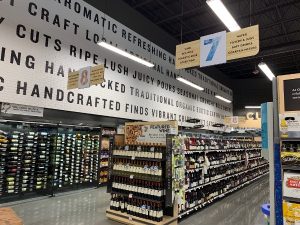Publix’s GreenWise stores have been around for a while. Why was it the right time to reinvigorate that brand?
Significant growth in customer demand for specialty, natural and organic products combined with learnings from our original Publix GreenWise Markets led us to believe that now is the right time.
How will these new locations differ from the traditional format?
They’ll have a much smaller footprint and a narrower product selection that focuses on specialty, natural and organic. Also, the GreenWise brand received a significant update, which is very apparent in the new store environment.
What are some key design elements in GreenWise?
A very clean and simple design aesthetic overall with just a touch of playful detail mixed in here and there. Typography and illustration are two design details that play an important role, but they’re used with thoughtful restraint so as to allow the products to be the hero. I think the outcome is a fresh, maybe unexpected, approach for a specialty/natural/organic store.
Advertisement
So visual at grocery is very important then?
Visual at grocery should not get in the way of product. It should be there to enhance product and help the customer navigate their journey through the store.
You mentioned that grocers have the potential to engage all five senses. How is this evident in the design of Publix stores?
It’s not just grocers, of course; all brick-and-mortar retail has the potential to do so. At Publix, it’s just about being thoughtful and intentional in leveraging the senses as an opportunity for engagement and doing so in a way that appropriately reflects our brand.
What about the “digital age”? How can grocers evolve to remain relevant?
[They can] continue to leverage the fact that brick-and-mortar stores have the potential to engage all five senses. Digital can’t do that. Our senses are the portals to our emotions, and an emotional connection can be magic.
Advertisement
What are you most proud of thus far in your career at Publix?
The creative team we’ve assembled here. They’ve done some outstanding work over the years. They’re world class!
How has the grocery/specialty food industry changed since you first started? That’s a long time!
Most of the change seems to have happened during the past 10 years. For years, grocery stores were all very similar and, for the most part, consumer behavior was similar: customers would go to the grocery store to shop for the meals they planned to cook at home. As customers’ lives got busier, they began to look for alternatives to cooking meals at home, and grocery stores responded by offering more prepared food options.
More recently, multiple alternatives have emerged: curbside pickup at restaurants (and grocery stores); online food options; small-format specialty markets; convenience stores selling groceries and prepared foods; drug stores selling groceries; high-end food stores; value food stores; food halls – the list goes on and on, really. Competition is much greater today.


 Photo Gallery2 weeks ago
Photo Gallery2 weeks ago
 Headlines6 days ago
Headlines6 days ago
 Headlines2 weeks ago
Headlines2 weeks ago
 Headlines2 weeks ago
Headlines2 weeks ago
 Headlines5 days ago
Headlines5 days ago
 Headlines2 weeks ago
Headlines2 weeks ago
 Headlines4 days ago
Headlines4 days ago
 Designer Dozen1 week ago
Designer Dozen1 week ago














